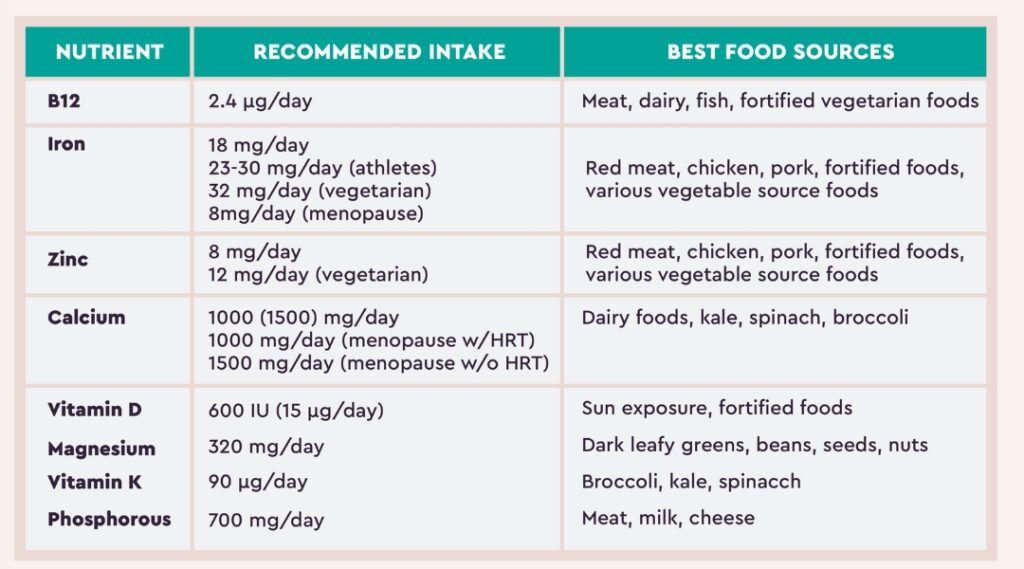It’s common to find women who are deficient in specific micronutrients (vitamins and minerals). Some micronutrients are critical for some aspects of health such as performance, fat loss or bone health.
A number of common nutrient deficiencies are frequently seen in this population including inadequate intakes of B12, iron, zinc, calcium, Vitamin D and magnesium. Each has its own important functions in the body and often interacts with one another.
VITAMIN B12
Vitamin B12 is involved in a huge number of physiological processes including red blood cell formation and neurological function.
Extreme deficiencies can cause what is called pernicious anemia, which is not the same type of anemia as is caused by iron deficiency and an autoimmune condition that can cause neurological disorders.
Vitamin B12 is only found naturally in animal-source foods such as meat and dairy foods although B12-fortified vegetarian foods are often available.
IRON
Iron is involved in a number of processes important to women, especially in red blood cell production, which is important for endurance and overall performance and thyroid hormone metabolism.
Having low iron stores have also been linked to problems with cognitive performance, emotions, quality of life and behaviour. Iron deficiency also interacts with most aspects of menstrual cycle dysfunction.
Iron status can be defined among different levels with anemia being the most extreme level of iron depletion. Iron can be found in red meat, chicken, pork, fortified foods, and various vegetable-sourced foods.
ZINC
Zinc is involved in numerous physiological processes including the metabolism of protein, carbohydrates and fats. Zinc also plays a role in immune system function.
Sufficient zinc is also critical for normal thyroid hormone metabolism. Diets low in these nutrients will decrease the level of thyroid hormones, lowering metabolic rate and energy expenditure and low thyroid levels are also one of the most common sources of misdiagnosed depression in women.
Zinc, like iron, is found in larger amounts in animal-source foods and is absorbed more effectively from these foods.
CALCIUM AND VITAMIN D
Calcium and Vitamin D are both critical for optimal bone health, both in terms of developing peak bone density in a woman’s younger years and limiting or reversing bone density loss as she gets older.
Calcium – has other roles in the body with dairy proteins having a potential role in fat loss and improving body composition.
Dairy foods are the primary source of calcium in the diet and are often found in dairy vegetable source foods but the amounts are lower and the calcium is absorbed less efficiently (calcium from dairy is absorbed with 97% efficiency versus 22% from broccoli)
Vitamin D – has a direct role on skeletal muscle with low levels impairing athletic performance. It is extremely unusual as a vitamin and outside of fortified foods, the levels found in most foods are quite low. Rather, Vitamin D is produced in the body in response to direct sun exposure.
VITAMIN K, PHOSPHOROUS, MAGNESIUM, ETC.
Vitamin K, phosphorous, magnesium and others (including iron, zinc, fluoride, protein and fat) are critical for optimal bone health.
Vitamin K is found primarily in leafy greens. Phosphorus is found in foods such as meat, dairy, nuts, beans and cereals (foods typically containing other nutrients that improve bone health).
Too much phosphorus combined with insufficient calcium can contribute negatively to bone health. Magnesium, which is often deficient in the diet and has numerous other physiological roles is found in whole grains, vegetables, nuts and seeds.
CAUSES OF MICRONUTRIENT DEFICIENCIES
Poor overall dietary patterns are the primary contributor and it is more likely for deficiencies to be seen in the micronutrients found in fruits and vegetables.
Eating inadequate amounts of foods containing essential nutrients or removing them from the diet completely is the main cause.
Exercise often increases nutrient requirements over normal levels but women tend not to increase their food intake while increasing their activity.
Women have a general tendency to remove many animal-source proteins such as red meat and dairy foods which reduces or eliminates the intake of critical nutrients in their most well-absorbed form.
RECOMMENDATIONS
Prioritise not only macronutrients but also micronutrients. Micronutrients such as vitamins and minerals should come from whole foods rather than isolated supplements as they are invariably absorbed more effectively from foods due to the presence of other nutrients and co-factors which are present. Both animal and vegetable foods should be part of a healthy and/or athletic diet.

Above is a table for recommended intakes and sources of the nutrients created by Lyle McDonald for women aged 18 and up. The values may change as recent studies are still exploiting the optimum amounts.
REFERENCE
McDonald, L. (2018). The Women’s Book: A Guide to Nutrition, Fat Loss, and Muscle Gain. Lyle. McDonald.
